22.02.2025
China readies Tianwen-2 asteroid sample return spacecraft for launch
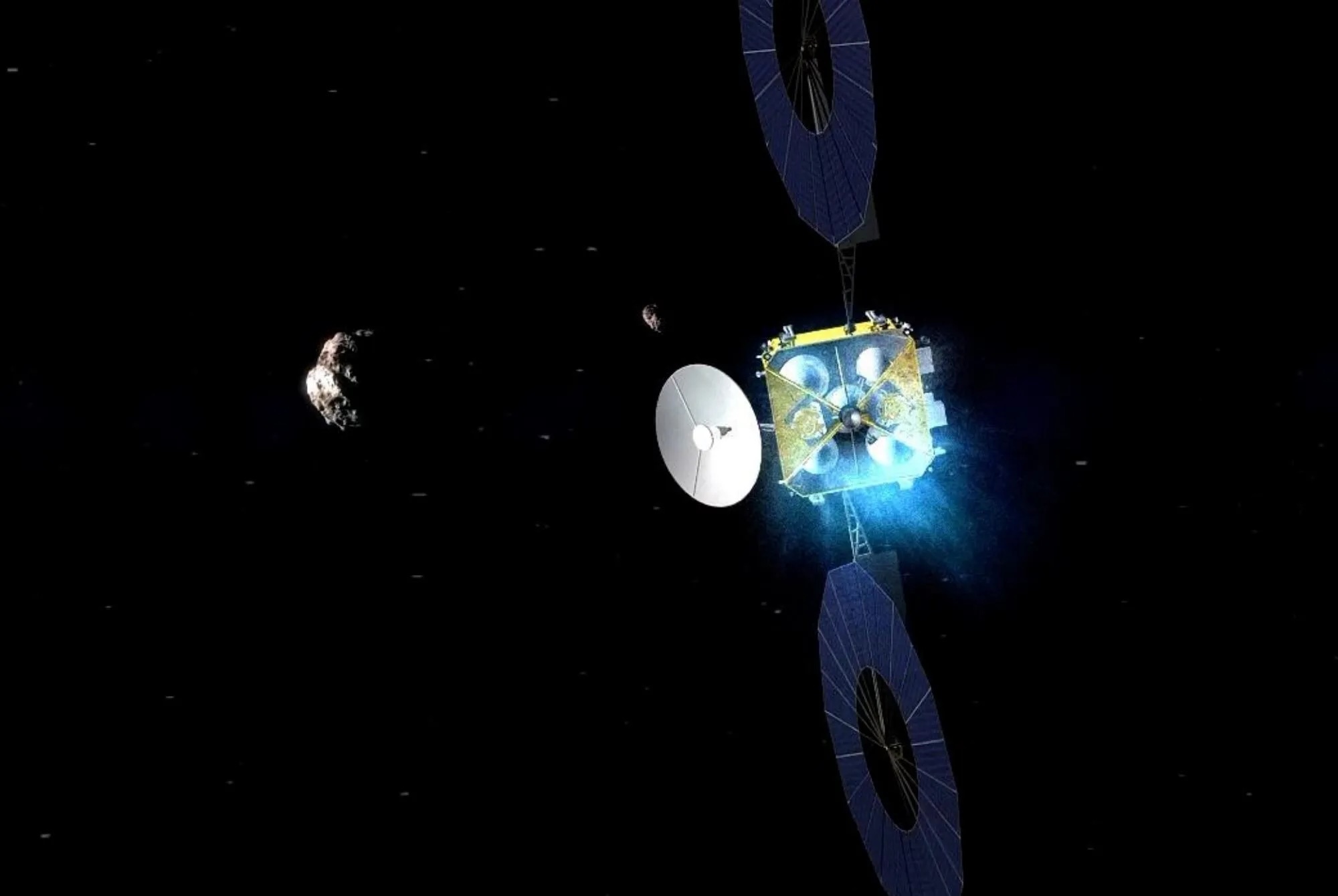
Render of the Tianwen-2 near-Earth asteroid/comet orbiter spacecraft. Credit: CNSA
HELSINKI — The spacecraft for China’s Tianwen-2 combined near-Earth asteroid sample return and comet rendezvous mission has arrived at Xichang spaceport for launch preparations.
The Tianwen-2 spacecraft arrived at Xichang Satellite Launch Center in Sichuan province, southwest China, Feb. 20, according to a statement from the China National Space Administration (CNSA).
CNSA stated vaguely that the launch is scheduled to be carried out in the first half of this year. The mission was previously stated by officials to launch around May 2025 on a Long March 3B rocket.
Tianwen-2 will first target near-Earth asteroid Kamoʻoalewa (2016 HO3), considered a quasi-satellite of Earth due to its co-orbital dynamics. It aims to collect samples from the roughly 40 to 100-meter-diameter asteroid and deliver them to Earth around 2027. Kamoʻoalewa is possibly a chunk of the moon blasted into space following an impact event, according to researchers.
The main spacecraft will then head for main-belt comet 311P/PANSTARRS, which has asteroid-like orbital characteristics but also features comet-like activity.
The two mission phases aim to provide insight into the composition and evolution of near-Earth objects and understand distribution of water and organic molecules and the history of the early solar system.
“The launch site facilities are in good condition, and the pre-launch test preparations are being carried out in an orderly manner as planned,” the statement read.
Sampling Kamoʻoalewa
Tianwen-2 will use two sampling techniques to collect material from the asteroid. These will be the touch-and-go (TAG) approach used by both NASA’s OSIRIS-REx and JAXA’s Hayabusa2, and an anchor-and-attach system featuring drills at the tips of landing legs.
Early proposals for the mission, then named Zheng He for the Chinese admiral and explorer born in the 14th Century, indicated the spacecraft would aim to collect between 200 and 1,000 grams of samples.
Analysis of the samples aims to reveal the nature and origin of the asteroid, analyze its mineral content and provide comparisons with other asteroids.
While China has conducted two successful sample return missions from the moon’s near and far sides with Chang’e-5 and last year’s Chang’e-6 mission, the velocity of the reentry module will be greater, adding new challenges. The China Aerospace Science and Technology Corporation (CASC) conducted high-altitude parachute deployment tests for the mission in 2023. In contrast to the lunar sampling missions, Kamoʻoalewa will have negligible gravity, requiring different approaches to settling on the body and obtaining samples.
China’s first excursion to an asteroid was a flyby of 4179 Toutatis in 2012, when the Chang’e-2 lunar orbiter made the pass as an extended mission objective.
Comet rendezvous
Delivering samples to Earth will not be the end of the mission. The spacecraft will release a return module which will reenter the atmosphere, but also use the approach to the planet for a gravitational slingshot maneuver. This will send the main spacecraft on its way to the main-belt comet 311P/PANSTARRS, with arrival scheduled for around 2034.
The comet is seen as an ideal target for studying transitional objects between asteroids and comets. It orbits between 1.94 and 2.44 astronomical units from the Sun and the spacecraft is expected to rendezvous with the body in the mid-2030s. The Tianwen-2 spacecraft will conduct remote sensing of the comet to characterize its orbit, shape, and rotation, examine its surface composition and volatile elements, and investigate dust emissions and activity mechanisms to understand cometary behavior in the main belt.
Tianwen-2 carries a suite of scientific instruments to analyze its targets. Multispectral and infrared spectrometers will study surface composition, while high-resolution cameras will map geological features. A radar sounder will probe subsurface structures, and a magnetometer will search for residual magnetic fields. Dust and gas analyzers will examine comet activity, and charged particle detectors will investigate solar wind interactions. The Space Research Institute of the Russian Academy of Sciences is understood to have contributed to the particle detectors.
Tianwen deep space series
The Tianwen-2 mission is part of China’s expanding deep space ambitions. it follows the Tianwen-1 Mars orbiter and landing mission launched in 2020. The Zhurong rover successfully landed on the Red Planet in 2021. Tianwen-3 will be a Mars sample return mission and will launch around late 2028 or 2030.
Tianwen-4 will launch around 2030. It will include a solar-powered Jupiter orbiter which will observe the system and then enter orbit around the moon Callisto. A smaller, radioisotope-powered spacecraft to make a flyby of Uranus.
Chinese researchers last year called for a focus on asteroid sample return missions, citing untapped potential for groundbreaking discoveries and technological innovation
Quelle: SN
----
Update: 25.02.2025
.
China Prepares for Launch of Tianwen 2 Asteroid Mission

China is gearing up for its first asteroid sample-return mission, Tianwen 2, which is set to launch in the coming months from the Xichang Satellite Launch Center in Sichuan province, according to the China National Space Administration (CNSA).
The space agency announced on Thursday that the robotic probe has already arrived at the launch facility. It stated that "facilities at the launch center are in good condition, and pre-launch preparations are underway as planned." The mission is scheduled to take place within the first half of the year.
Tianwen 2 represents China's second interplanetary venture and is designed to explore the asteroid 2016 HO3, also known as 469219 Kamo'oalewa. This celestial body is the smallest and closest-known quasi-satellite of Earth.
The mission architecture consists of a probe with two key components-an orbiter and a reentry module-launched aboard a large carrier rocket. Upon reaching its target, the spacecraft will enter orbit around 2016 HO3 and then maneuver closer to collect surface samples using a mechanical arm.
After retrieving the material, Tianwen 2 will journey back to Earth's orbit, where it will release its reentry module to safely return the samples to the ground. Following this phase, the orbiter will continue its mission, heading toward the main-belt comet 311P to conduct further scientific investigations.
More than 1 million asteroids have been identified in the solar system, with over 20,000 classified as near-Earth objects. Scientists first detected 2016 HO3 in April 2016 at Hawaii's Haleakala Observatories using an asteroid survey telescope. The asteroid remains in a stable orbit around the Sun while maintaining a close relationship with Earth. Researchers believe it may hold vital clues about the early history and composition of the solar system.
Meanwhile, 311P is located within the asteroid belt between Mars and Jupiter. Though its physical properties resemble those of comets, its orbital behavior aligns more closely with asteroids. Studying this object could provide new insights into the structure, composition, and evolution of small celestial bodies, offering valuable knowledge about solar system formation.
The Tianwen program, named after an ancient Chinese poem, encompasses China's interplanetary exploration ambitions. The first mission, Tianwen 1, was launched in July 2020 and successfully landed on Mars in May 2021. It deployed the Zhurong rover, which became the sixth robotic explorer to operate on the Martian surface, following five previous U.S. missions.
Quelle: SD
----
Update: 19.05.2025
.
Tianwen-2 probe scheduled for launch at end of May
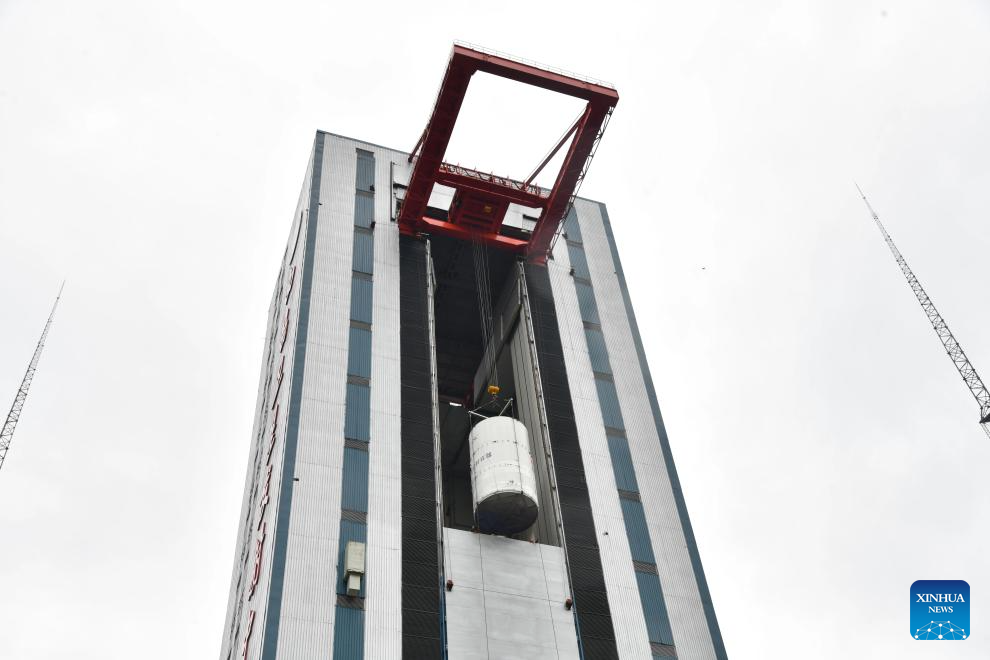
China's Tianwen-2 probe is transported to its launch area, after completing its scheduled assembly, testing and fueling at the technical area of the Xichang Satellite Launch Center in southwest China's Sichuan Province, May 18, 2025. The probe is scheduled for launch at the end of May, according to the China National Space Administration (CNSA) on Sunday. It will subsequently conduct functional checks and joint tests. Previously, the Long March-3B Y110 rocket, which will carry out the Tianwen-2 launch mission, was transferred from the technical area to the launch area on May 14 and completed lifting and docking operations, said the CNSA. (Photo by Shi Yichen/Xinhua)
China's Tianwen-2 probe is scheduled for launch at the end of May, according to the China National Space Administration (CNSA) on Sunday.
The probe has been transported to its launch area, after completing its scheduled assembly, testing and fueling at the technical area of the Xichang Satellite Launch Center in southwest China's Sichuan Province.
It will subsequently conduct functional checks and joint tests.
Previously, the Long March-3B Y110 rocket, which will carry out the Tianwen-2 launch mission, was transferred from the technical area to the launch area on May 14 and completed lifting and docking operations, said the CNSA.
China's Tianwen-2 probe is transported to its launch area, after completing its scheduled assembly, testing and fueling at the technical area of the Xichang Satellite Launch Center in southwest China's Sichuan Province, May 18, 2025.
The probe is scheduled for launch at the end of May, according to the China National Space Administration (CNSA) on Sunday.
It will subsequently conduct functional checks and joint tests.
Previously, the Long March-3B Y110 rocket, which will carry out the Tianwen-2 launch mission, was transferred from the technical area to the launch area on May 14 and completed lifting and docking operations, said the CNSA. (Photo by Shi Yichen/Xinhua)

China's Tianwen-2 probe is transported to its launch area, after completing its scheduled assembly, testing and fueling at the technical area of the Xichang Satellite Launch Center in southwest China's Sichuan Province, May 18, 2025.
The probe is scheduled for launch at the end of May, according to the China National Space Administration (CNSA) on Sunday.
It will subsequently conduct functional checks and joint tests.
Previously, the Long March-3B Y110 rocket, which will carry out the Tianwen-2 launch mission, was transferred from the technical area to the launch area on May 14 and completed lifting and docking operations, said the CNSA. (Photo by Shi Yichen/Xinhua)
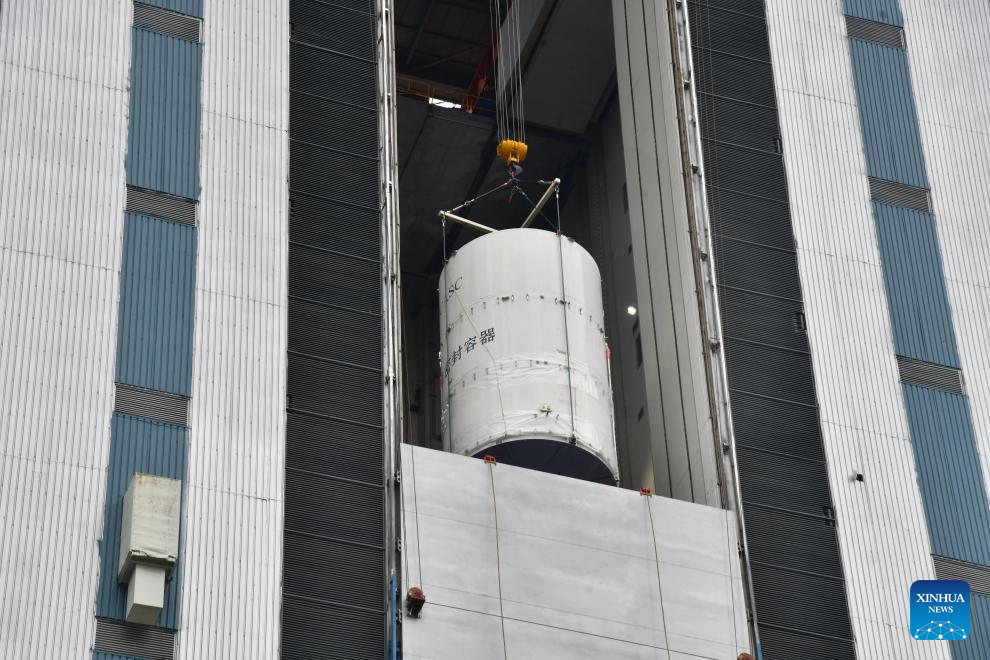
China's Tianwen-2 probe is transported to its launch area, after completing its scheduled assembly, testing and fueling at the technical area of the Xichang Satellite Launch Center in southwest China's Sichuan Province, May 18, 2025.
The probe is scheduled for launch at the end of May, according to the China National Space Administration (CNSA) on Sunday.
It will subsequently conduct functional checks and joint tests.
Previously, the Long March-3B Y110 rocket, which will carry out the Tianwen-2 launch mission, was transferred from the technical area to the launch area on May 14 and completed lifting and docking operations, said the CNSA. (Photo by Shi Yichen/Xinhua)

China's Tianwen-2 probe is transported to its launch area, after completing its scheduled assembly, testing and fueling at the technical area of the Xichang Satellite Launch Center in southwest China's Sichuan Province, May 18, 2025.
The probe is scheduled for launch at the end of May, according to the China National Space Administration (CNSA) on Sunday.
It will subsequently conduct functional checks and joint tests.
Previously, the Long March-3B Y110 rocket, which will carry out the Tianwen-2 launch mission, was transferred from the technical area to the launch area on May 14 and completed lifting and docking operations, said the CNSA. (Photo by Shi Yichen/Xinhua)

China's Tianwen-2 probe is transported to its launch area, after completing its scheduled assembly, testing and fueling at the technical area of the Xichang Satellite Launch Center in southwest China's Sichuan Province, May 18, 2025.
The probe is scheduled for launch at the end of May, according to the China National Space Administration (CNSA) on Sunday.
It will subsequently conduct functional checks and joint tests.
Previously, the Long March-3B Y110 rocket, which will carry out the Tianwen-2 launch mission, was transferred from the technical area to the launch area on May 14 and completed lifting and docking operations, said the CNSA. (Photo by Shi Yichen/Xinhua)
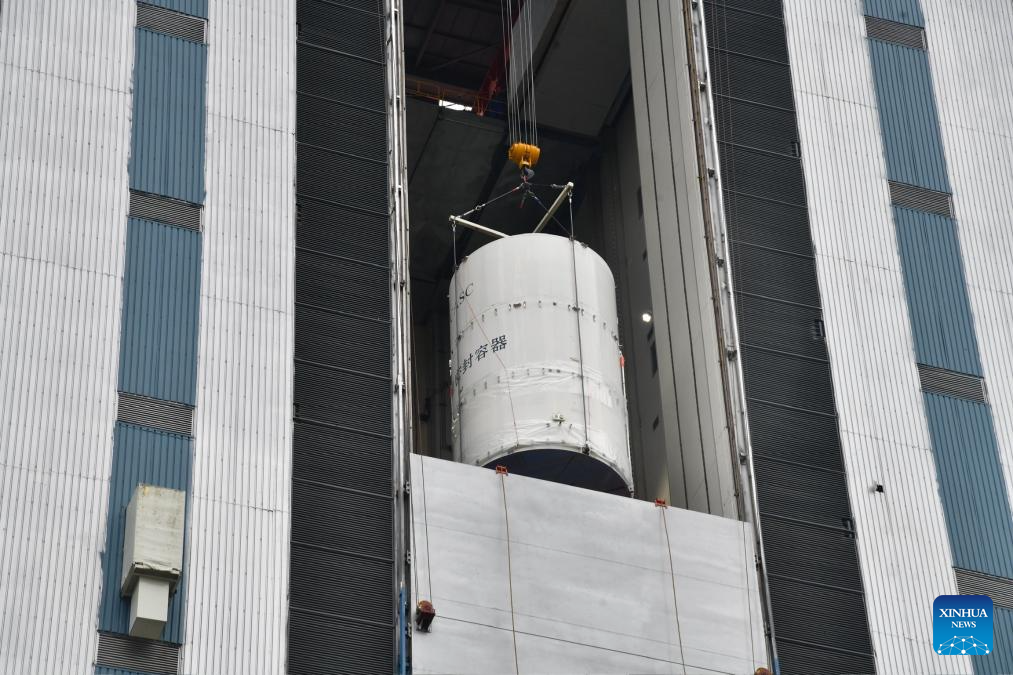
China's Tianwen-2 probe is transported to its launch area, after completing its scheduled assembly, testing and fueling at the technical area of the Xichang Satellite Launch Center in southwest China's Sichuan Province, May 18, 2025.
The probe is scheduled for launch at the end of May, according to the China National Space Administration (CNSA) on Sunday.
It will subsequently conduct functional checks and joint tests.
Previously, the Long March-3B Y110 rocket, which will carry out the Tianwen-2 launch mission, was transferred from the technical area to the launch area on May 14 and completed lifting and docking operations, said the CNSA. (Photo by Shi Yichen/Xinhua)
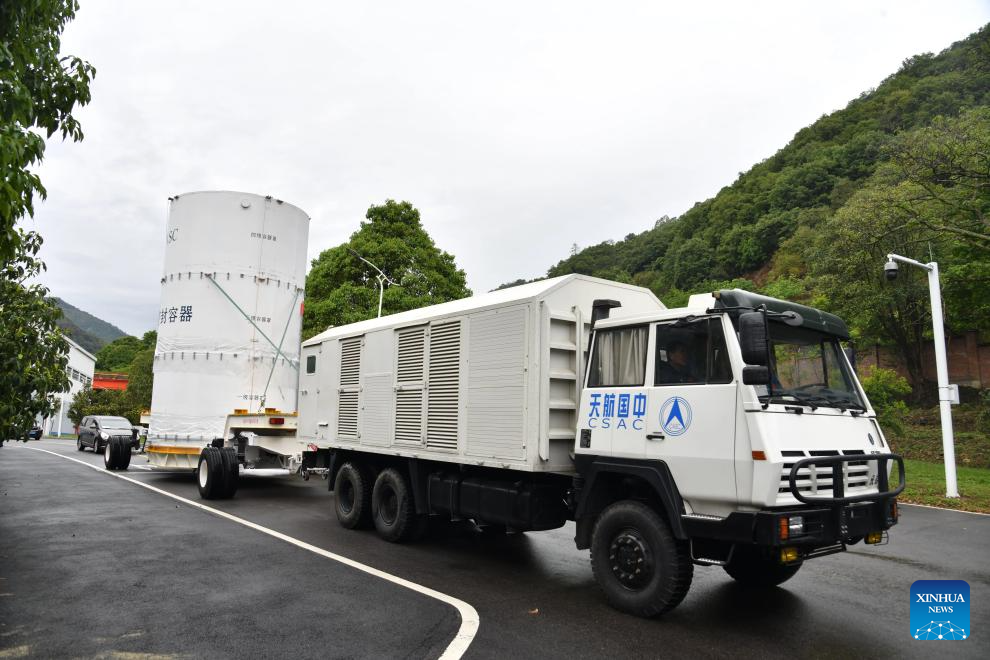
China's Tianwen-2 probe is transported to its launch area, after completing its scheduled assembly, testing and fueling at the technical area of the Xichang Satellite Launch Center in southwest China's Sichuan Province, May 18, 2025.
The probe is scheduled for launch at the end of May, according to the China National Space Administration (CNSA) on Sunday.
It will subsequently conduct functional checks and joint tests.
Previously, the Long March-3B Y110 rocket, which will carry out the Tianwen-2 launch mission, was transferred from the technical area to the launch area on May 14 and completed lifting and docking operations, said the CNSA. (Photo by Shi Yichen/Xinhua)
Quelle: Xinhua
----
Update: 28.05.2025
.
China to launch Tianwen-2 probe for asteroid sampling on May 29
China's Tianwen-2 probe is scheduled for launch on May 29, aiming to unravel the mysteries of a near-Earth asteroid and a main-belt comet, the China National Space Administration (CNSA) announced on Monday.
The Tianwen-2 probe will collect samples from the near-Earth asteroid 2016HO3, which marks China's first-ever asteroid sampling, and explore the main-belt comet 311P, the agency said.
Currently, all mission preparations are progressing smoothly at the Xichang Satellite Launch Center in southwest China's Sichuan Province and propellant loading of the Long March-3B Y110 rocket, which will execute the launch mission, is set to begin soon, the CNSA said.
Previously, the Tianwen-2 probe had completed a series of planned procedures including assembly, testing, fueling, relocation, functional checks, and joint tests, it said.
The rocket, transferred from the technical area to the launch area on May 14, has completed docking operations, payload integration, fairing assembly, and overall inspection and testing, it said, adding that coordinated drills were also conducted among various control centers and monitoring sites.
Discovered in 2016 by the Pan-STARRS telescope in Hawaii, the asteroid 2016HO3 is a quasi-satellite of Earth, located millions to tens of millions of kilometers away from Earth.
The asteroid, which runs stably near the Earth's orbit, contains ancient materials from the early solar system, making it a "living fossil" that is useful for studying how the solar system formed and evolved.
The main-belt comet 311P, a celestial anomaly that orbits in the main asteroid belt between Mars and Jupiter, was discovered by American scientists in 2013. Regarded as a "rebel" of the main asteroid belt, it displays features of both comets and asteroids.
Studying it will provide researchers with valuable insights about the composition, structure and evolution of small space objects, helping to fill gaps in our understanding of the solar system.
Quelle: Xinhua
----
Update: 29.05.2025
.
China launches Tianwen-2 mission to sample near Earth asteroid
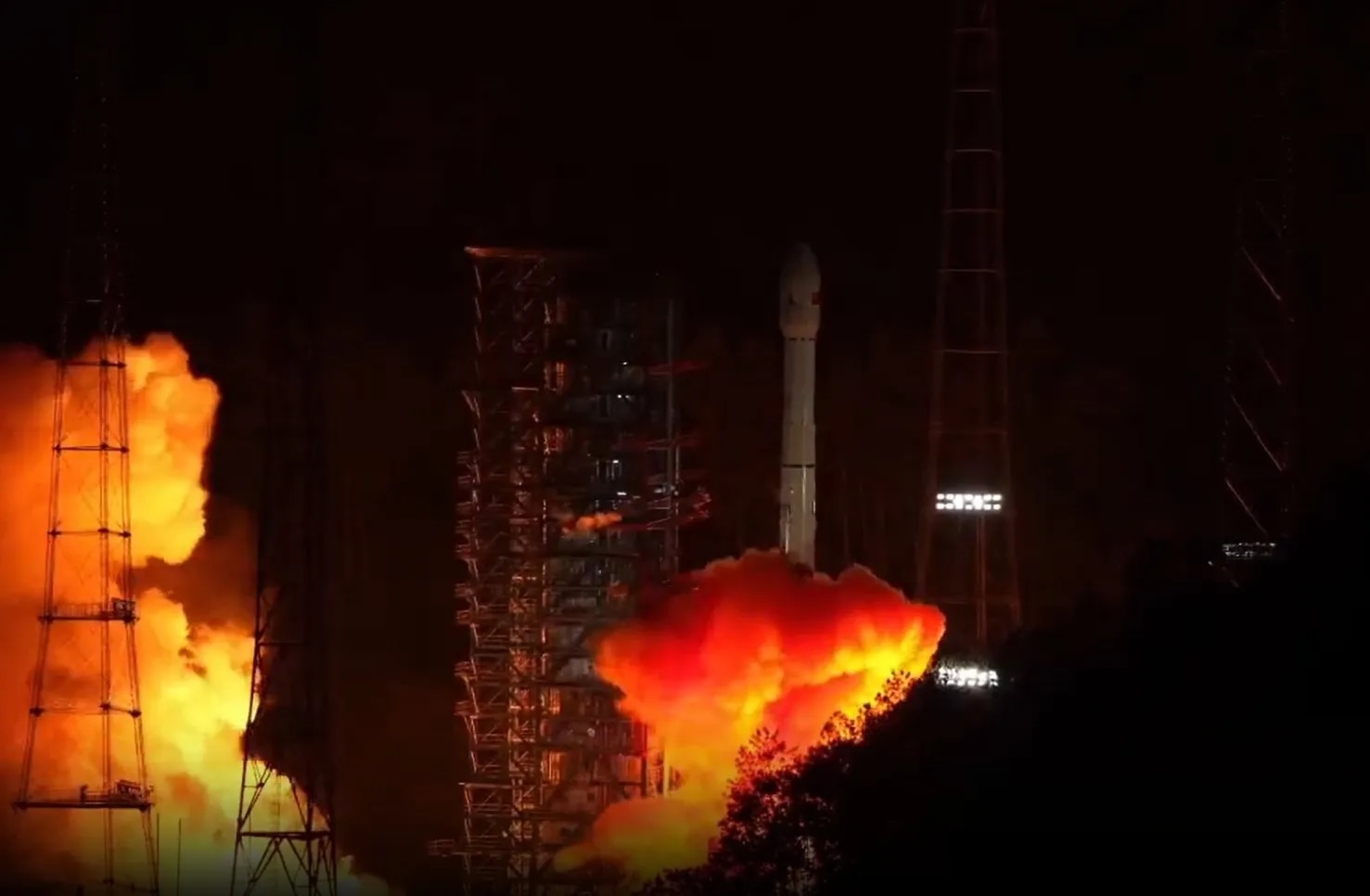
Liftoff of the Long March 3B Y110 from Xichang, carrying the Tianwen-2 spacecraft into orbit, May 28, 2025. Credit: CASC
HELSINKI — China launched its second planetary exploration mission Wednesday, sending Tianwen-2 to sample a near Earth asteroid and later survey a main belt comet.
Tianwen-2 lifted off on a Long March 3B rocket at 1:31 p.m. Eastern (1731 UTC) from Xichang Satellite Launch Center, southwest China, climbing into the night sky above the spaceport.
The China Aerospace Science and Technology Corporation (CASC) announced the successful launch of Tianwen-2 just over an hour after liftoff.
Tianwen-2 is now in a transfer orbit, headed for the 40 to 100-meter-diameter near-Earth asteroid 469219 Kamoʻoalewa (2016 HO3). It is expected to rendezvous with the small, rocky body around July 2026, spending seven months studying the near Earth object and collecting samples. The samples are expected to be returned to Earth in late 2027.
Analysis of the samples aims to reveal the nature and origin of the asteroid—which is possibly a piece of the moon blasted into space following an impact event—analyze its mineral content and provide valuable comparisons with other asteroids.
Tianwen-2 will release a reentry module containing the samples on return to the Earth, but this will not be the end of the mission. The main spacecraft will use the Earth for gravitational swingby, setting it on course for a six-year-voyage to comet 311P/PANSTARRS.
Small body complexity, science potential
The asteroid and comet mission will provide China with a range of experience and expertise in mission design and operations, such as advancing spacecraft autonomy, navigation, planning orbits and sampling technologies in extremely challenging environments, Franco Perez-Lissi, Ramses mission systems engineer at the European Space Agency (ESA), told SpaceNews.
While China has conducted two lunar sample return missions, including the moon’s far side, approaching and “orbiting” these small objects will bring new challenges, in terms of rendezvous, approach and sampling.
“These bodies have extremely weak and irregular gravity fields,” Perez-Lissi said, referring to asteroids and comets. “So we cannot rely on traditional orbiting like we do around the planet.”
Tianwen-2 will need to fly in carefully planned trajectories to maneuver around and study the asteroid, as well as match its speed and rotation for sampling.
“It’s like trying to dock a boat with a mountain floating in space and tumbling really unpredictably and with almost no gravity. So landing, or even just flying close, requires extreme precision, greater autonomy and careful planning,” Perez-Lissi said.
The science and data return will also be of great value, with Perez-Lissi noting that past missions such as Rosetta, Hayabusa2 and OSIRIS-REx showed that in-situ measurements or returned samples can contain organic molecules, amino acids, and nucleobases—potential ingredients for life.
Tianwen-2 joins a number of international efforts which contribute to shared scientific and planetary defense knowledge, notably ESA missions Ramses and Hera, NASA’s DART and OSIRIS-REx/Apex missions, and JAXA’s Hayabusa series and Destiny+.
“It’s always very positive that more and more people are venturing into asteroid missions. It may well be helpful for the future, since we are engaging in planetary defense, but also it’s extremely interesting for science and to understand our origins.”
Tianwen series and long-term exploration
The mission follows the successful Tianwen-1 Mars orbiter and rover mission launched in 2020, and will be followed by ambitious Mars sample return (Tianwen-3) and Jupiter system (Tianwen-4) missions later in the decade.
Tianwen-2 aims to advance China’s planetary exploration capabilities and deepen our understanding of small planetary bodies and their evolution. It could also contribute to planetary defense and shed light on the origins of life.
The missions are also part of a wider planetary exploration roadmap focused on astrobiology and habitability, and a long-term plan for space science, including a Venus sample return mission, the International Lunar Research Station (ILRS) and searching for habitable exoplanets.
Asteroid ambitions
The spacecraft will attempt up to three methods of sampling: hover sampling, collecting samples with a robotic arm while matching the asteroid’s rotation; touch-and-go (TAG), using a rotating brush head; and anchored sampling, in which landing legs would use drills at the end of landing legs to press into the asteroid, if the surface composition and terrain allow. The TAG approach was used by both NASA’s OSIRIS-REx and JAXA’s Hayabusa2.
China has released few official detailed plans for the mission. Early proposals for the mission, then named Zheng He for the Chinese admiral and explorer born in the 14th Century, indicated the mission would aim to collect between 200 and 1,000 grams of samples.
Chinese scientists have called for a strategic focus on asteroid missions, which could both contribute to overall understanding of the cosmos and also lay the groundwork for future space resource utilization and planetary defense.
Comet rendezvous, wider context
The comet phase of the mission will also be a test in terms of longevity of the spacecraft, with arrival at 311P/PANSTARRS expected around 2035, a decade after liftoff. The target comet is seen as an ideal target for studying transitional objects between asteroids and comets, orbiting between 1.94 and 2.44 astronomical units from the Sun.
Tianwen-2 carries 11 science payloads for studying both Kamoʻoalew and 311P/PANSTARRS. These include multispectral and infrared spectrometers to study surface composition, while high-resolution cameras will map geological features. A radar sounder will probe subsurface structures, and a magnetometer will search for residual magnetic fields. Dust and gas analyzers will examine comet activity, and charged particle detectors will investigate solar wind interactions.
The mission to sample Kamoʻoalewa and later survey a main belt comet sees China join a growing global context of missions tackling the complex environment of small-body exploration, demonstrating its expanding ambitions in space.
It will also allow China’s engineers and scientists to test themselves against some of the toughest problems in terms of planetary science and defense, and potentially resource utilization.
Quelle: SN
+++
China launches Tianwen-2 to retrieve asteroid samples

China's Tianwen-2 probe, atop a Long March-3B carrier rocket, lifts off from the Xichang Satellite Launch Center in southwest China's Sichuan Province, May 29, 2025. China launched its first asteroid sample-return mission, Tianwen-2, in the early hours of Thursday, an endeavour to shed light on the formation and evolution of asteroids and the early solar system. The Tianwen-2 mission aims to achieve multiple goals over a decade-long expedition: collecting samples from the near-Earth asteroid 2016HO3 and exploring the main-belt comet 311P, which is more distant than Mars. (Xinhua/Cai Yang)
China launched its first asteroid sample-return mission, Tianwen-2, in the early hours of Thursday, an endeavour to shed light on the formation and evolution of asteroids and the early solar system.
The Tianwen-2 mission aims to achieve multiple goals over a decade-long expedition: collecting samples from the near-Earth asteroid 2016HO3 and exploring the main-belt comet 311P, which is more distant than Mars.
A Long March-3B carrier rocket blasted off from the Xichang Satellite Launch Center in southwest China's Sichuan Province at 1:31 a.m. (Beijing Time). And about 18 minutes later, the Tianwen-2 probe was sent into a transfer orbit from Earth to the asteroid 2016HO3, according to the China National Space Administration (CNSA).
The spacecraft unfolded its solar panels smoothly, and the CNSA declared the launch a success.
Shan Zhongde, head of the CNSA, stated that the Tianwen-2 mission represents a significant step in China's new journey of interplanetary exploration.
Despite the mission's long duration and significant risks, he expressed his expectation of yielding groundbreaking discoveries and expanding humanity's knowledge of the cosmos.
POTENTIAL SCIENTIFIC BREAKTHROUGHS
Known as a quasi-satellite of Earth, asteroid 2016HO3 orbits the Sun and appears to circle around Earth as well, remaining a constant companion to our planet.
Dubbed as "cosmic fossils," asteroids preserve critical information about the solar system's infancy, scientists say.
"Asteroids also provide critical insights into Earth's evolutionary history. A hypothesis holds that Earth's water was brought by small celestial bodies. Their cataclysmic collisions with our planet, such as the event that eradicated dinosaurs, have profoundly shaped terrestrial evolution," said Liu Jianjun, deputy chief designer of the Tianwen-2 mission and a researcher from the National Astronomical Observatories of the Chinese Academy of Sciences.
The second target, 311P, a celestial anomaly discovered in the main asteroid belt between Mars and Jupiter, occasionally spews out materials and resembles a comet with tails. Its discovery challenges astronomers' conventional understanding about a comet, as the region is too close to the Sun for a comet to retain its volatile materials like water ice.
Scientists are still uncertain whether main-belt comets originated in the asteroid belt or from the edge of the solar system. These special small celestial bodies hold significant scientific research value, Liu said.
Explaining why the asteroid 2016HO3 was chosen for sampling, Han Siyuan, deputy director of the CNSA's Lunar Exploration and Space Engineering Center and spokesperson for the Tianwen-2 mission, said this asteroid has a relatively stable orbit, requiring lower energy consumption for spacecraft to reach it, while enabling a viable scenario for subsequent exploration of the main-belt comet 311P.
The Tianwen-2 mission is expected to advance understanding of the origins, evolution and characteristics of these two types of small celestial bodies, Han said.
Scientifically, the mission focuses on measuring physical parameters of the two celestial targets, including their orbital dynamics, rotation, size, shape and thermal properties.
The mission will also investigate the topography, composition and internal structure of the two celestial bodies, and possibly study the materials ejected by the main-belt comet, Han said.
After the samples are brought back to Earth, laboratory analysis will be carried out to determine the samples' physical properties, chemical and mineral composition and structural characteristics, he added.
NEW STEP IN DEEP SPACE
The entire mission process is complex. After launch, the spacecraft will journey for about one year to reach its first target, during which it will perform deep-space maneuvers and mid-course corrections until it is about 30,000 km away from 2016HO3.
The probe will gradually approach the target, carrying out close exploration by circling and hovering over the asteroid to determine the sampling area, with a strategy of flying and probing simultaneously.
Given the asteroid's weak gravity, sampling poses unique challenges. A hard surface may result in bouncing back, while a loose surface may cause sinking. The control of the probe must be precise and just right, Han said.
After completing the sampling, the spacecraft will fly back to the vicinity of Earth. A return capsule will separate from the main probe and is expected to deliver the samples to Earth by the end of 2027.
The main probe will then continue its voyage to rendezvous with the more distant target, the main-belt comet 311P, to carry out subsequent exploration tasks.
The probe is equipped with a suite of scientific instruments, including cameras, a visible and infrared imaging spectrometer, a thermal emission spectrometer, radar, a magnetometer, and analyzers for charged and neutral particles, as well as for ejected materials, according to the CNSA.
SUBSTANTIAL RISKS
The mission aims to overcome key technological challenges, including sampling on a low-gravity celestial surface, high-precision autonomous navigation and control, as well as trajectory design, according to the CNSA.
"Earth-based observations indicate that the asteroid 2016HO3, with an average diameter of about 41 meters, exists in near-zero gravity and rotates rapidly. Given these complex conditions, it's extremely challenging for the probe to achieve stable attachment with the asteroid and sampling within a limited time," Han said.
Asteroid 2016HO3 is located between 18 million km and 46 million km from Earth, while the main-belt comet 311P lies approximately 150 million km to 500 million km away. The immense distance from Earth imposes stringent requirements on the probe's communication system, trajectory design, power management, and the capability to maintain highly reliable long-term operational performance, Han said.
"The most formidable challenge we face lies in the multitude of unknowns regarding our exploration targets. The asteroid's shape, rotational behavior and surface characteristics all remain unclear, which significantly complicated the design of both the spacecraft and its sampling methods," said Chen Chunliang, an expert from the China Aerospace Science and Technology Corporation.
"To address these uncertainties, we've conducted extensive ground-based simulations, enabling the probe to employ multiple contingency strategies," Chen said.
"Additionally, we've engineered lightweight, large-area flexible solar panels to ensure a sustained power supply during the deep-space voyage," Chen added.
The mission's name originates from the long poem "Tianwen," meaning "Questions to Heaven," written by Qu Yuan (about 340-278 BC), one of the greatest poets of ancient China. The poem poses philosophical and cosmological queries about heaven, stars, myths, and nature, reflecting a spirit of seeking the truth.
CNSA noted that all of China's interplanetary missions bear the Tianwen series name, symbolizing the nation's enduring pursuit of truth and exploring nature and the universe. China's first Mars exploration mission was named Tianwen-1.
Quelle: Xinhua
----
Update: 7.06.2025
.
Tianwen-2 probe operating smoothly in orbit: CNSA
As of Friday morning, the Tianwen-2 probe had been operating smoothly in orbit for over eight days, reaching a distance of more than 3 million kilometers from Earth, according to the China National Space Administration (CNSA) Friday.
The CNSA also released an image captured by the probe, showing one unfolded solar panel.
China launched its first asteroid sample-return mission, Tianwen-2, on May 29, an endeavour to shed light on the formation and evolution of asteroids and the early solar system.
The Tianwen-2 mission aims to achieve multiple goals over a decade-long expedition: collecting samples from the near-Earth asteroid 2016HO3 and exploring the main-belt comet 311P, which is more distant than Mars.
To meet the power demands during the deep-space voyage, the Tianwen-2 probe is equipped with circular, flexible solar panels.
Quelle: Xinhua
